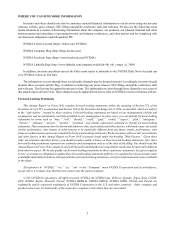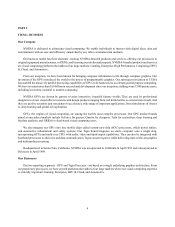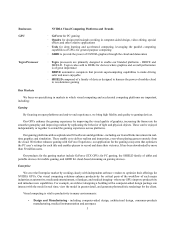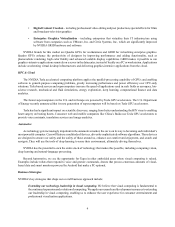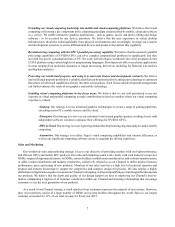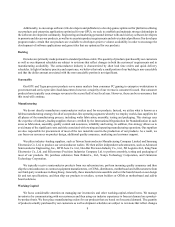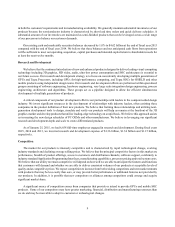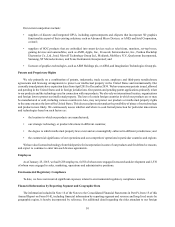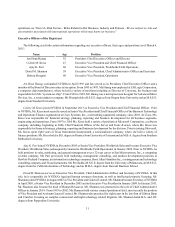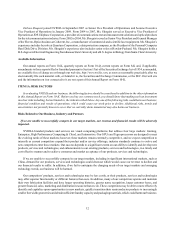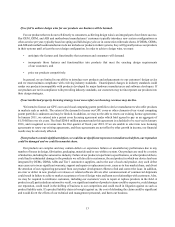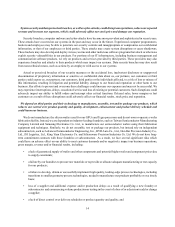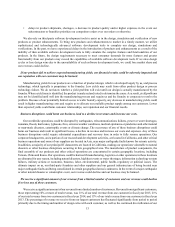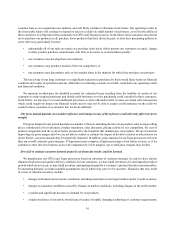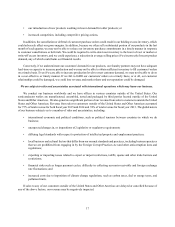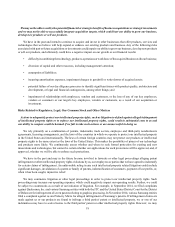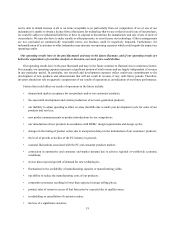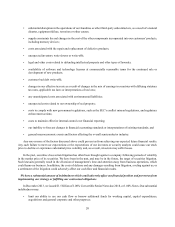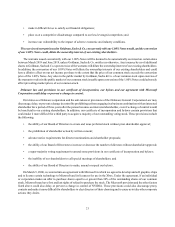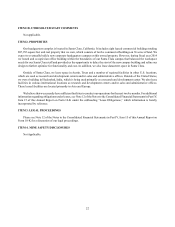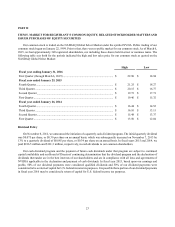NVIDIA 2015 Annual Report Download - page 93
Download and view the complete annual report
Please find page 93 of the 2015 NVIDIA annual report below. You can navigate through the pages in the report by either clicking on the pages listed below, or by using the keyword search tool below to find specific information within the annual report.13
If we fail to achieve design wins for our products our business will be harmed.
For our products that we do not sell directly to consumers, achieving design wins is an integral part of our future success.
Our OEM, ODM, and AIB and motherboard manufacturers' customers typically introduce new system configurations as
often as twice per year, typically based on spring and fall design cycles or in connection with trade shows. If OEMs, ODMs,
and AIB and motherboard manufacturers do not include our products in their systems, they will typically not use our products
in their systems until at least the next design configuration. In order to achieve design wins, we must:
• anticipate the features and functionality that customers and consumers will demand;
• incorporate those features and functionalities into products that meet the exacting design requirements
of our customers; and
• price our products competitively.
In general, we are limited in our ability to introduce new products and enhancements to our customers' design cycles
and we must maintain compliance with evolving industry standards. Unanticipated changes in industry standards could
render our products incompatible with products developed by major hardware manufacturers and software developers. If
our products are not in compliance with prevailing industry standards, our customers may not incorporate our products into
their design strategies.
If our intellectual property licensing strategy is not successful, our licensing revenues may decline.
We intend to license our GPU cores and visual computing patent portfolio to device manufacturers who offer products
in markets such as mobile. The extent of the demand to license our GPU cores or other elements of our visual computing
patent portfolio is unknown and may be limited. In addition, we may not be able to renew our existing license agreements.
In January 2011, we entered into a patent cross licensing agreement under which Intel agreed to pay us an aggregate of
$1.50 billion over six years. The final $200.0 million payment under this agreement is scheduled to be received in January
2016, and recognized as revenue into the first quarter of fiscal year 2018. If we are unable to enter into new licensing
agreements or renew our existing agreements, and these agreements are not offset by other growth in income, our financial
results may be adversely affected.
If our products contain significant defects, we could incur significant expenses to remediate such defects, our reputation
could be damaged and we could lose market share.
Our products are complex and may contain defects or experience failures or unsatisfactory performance due to any
number of issues in design, fabrication, packaging, materials and/or use within a system. Our products are used by a variety
of industries, including the automotive industry. Failure of our products to perform to specifications, or other product defects,
could lead to substantial damage to the products we sell directly to customers, the end product in which our device has been
integrated by OEMs, ODMs, AIBs and Tier 1 automotive suppliers, and to the user of such end product. Any such defect
may cause us to incur significant warranty, support and repair or replacement costs, cause us to lose market share, and divert
the attention of our engineering personnel from our product development efforts to find and correct the issue. In addition,
an error or defect in new products or releases or related software drivers after commencement of commercial shipments
could result in failure to achieve market acceptance or loss of design wins and harm our relationships with customers. Also,
we may be required to reimburse customers, including our customers' costs to repair or replace products in the field. A
product recall, particularly an automotive recall, or a significant number of product returns could be expensive, could damage
our reputation, could result in the shifting of business to our competitors and could result in litigation against us such as
product liability suits. If a product liability claim is brought against us, the cost of defending the claim could be significant
and would divert the efforts of our technical and management personnel, and harm our business.


